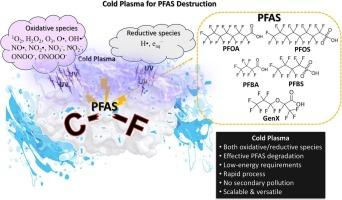PFAS修复技术的创新:冷等离子体技术日益重要的作用综述
IF 9
1区 工程技术
Q1 ENGINEERING, CHEMICAL
引用次数: 0
摘要
全氟烷基和多氟烷基物质(PFAS)是一类高度持久性和生物蓄积性的环境污染物,因其流动性、毒性和耐降解性而引起全球关注。传统的处理技术往往无法达到足够高的破坏水平,特别是在地下水、废水或土壤等复杂基质中。在这种情况下,冷等离子体技术已经成为一种有前途的、无化学物质的方法,可以有效和节能地降解PFAS。冷等离子体产生丰富的氧化和还原性物质、电子、紫外线光子和电场的混合物,能够破坏PFAS化合物所特有的强碳氟键。本文综述了冷等离子体在水相和固相环境中修复PFAS的最新研究成果。它系统地检查了等离子体类型和反应器配置的影响,以及工作气体、水基质、等离子体电参数和处理条件对降解效率的影响。详细分析了等离子体化学、能量消耗、pH、处理时间、PFAS结构等关键因素。该综述还讨论了机制见解、降解途径以及扩展冷等离子体系统用于实际应用的主要挑战,包括能源需求和与现有基础设施的集成。通过批判性地综合目前的研究结果,本文强调了冷等离子体在PFAS破坏中的日益重要的作用,并确定了推进其在环境修复中的实际应用所必需的研究空白和技术方向。本文章由计算机程序翻译,如有差异,请以英文原文为准。

Innovations in PFAS remediation: a review on the growing role of cold plasma technology
Per- and polyfluoroalkyl substances (PFAS) are a class of highly persistent and bioaccumulative environmental contaminants that have raised global concern due to their mobility, toxicity, and resistance to degradation. Conventional treatment technologies often fall short in achieving sufficiently high levels of destruction, particularly in complex matrices such as groundwater, wastewater, or soil. In this context, cold plasma technology has emerged as a promising, chemical-free approach for the effective and energy-efficient degradation of PFAS. Cold plasma produces a rich mixture of oxidative and reductive species, electrons, UV photons, and electric fields, capable of breaking down the strong carbon‑fluorine bonds characteristic of PFAS compounds. This critical review provides a comprehensive assessment of recent research efforts on the application of cold plasma for PFAS remediation from aqueous and solid-phase environments. It systematically examines the influence of plasma types and reactor configurations, along with working gases, water matrices, plasma electrical parameters, and treatment conditions on degradation efficiency. Key factors such as plasma chemistry, energy consumption, pH, treatment duration, and PFAS structure are analyzed in detail. The review also addresses mechanistic insights, degradation pathways, and the main challenges for scaling cold plasma systems for real-world applications, including energy demand and integration with existing infrastructure. By critically synthesizing current findings, this review highlights the growing role of cold plasma in PFAS destruction and identifies research gaps and technological directions necessary to advance its practical deployment in environmental remediation.
求助全文
通过发布文献求助,成功后即可免费获取论文全文。
去求助
来源期刊

Separation and Purification Technology
工程技术-工程:化工
CiteScore
14.00
自引率
12.80%
发文量
2347
审稿时长
43 days
期刊介绍:
Separation and Purification Technology is a premier journal committed to sharing innovative methods for separation and purification in chemical and environmental engineering, encompassing both homogeneous solutions and heterogeneous mixtures. Our scope includes the separation and/or purification of liquids, vapors, and gases, as well as carbon capture and separation techniques. However, it's important to note that methods solely intended for analytical purposes are not within the scope of the journal. Additionally, disciplines such as soil science, polymer science, and metallurgy fall outside the purview of Separation and Purification Technology. Join us in advancing the field of separation and purification methods for sustainable solutions in chemical and environmental engineering.
 求助内容:
求助内容: 应助结果提醒方式:
应助结果提醒方式:


